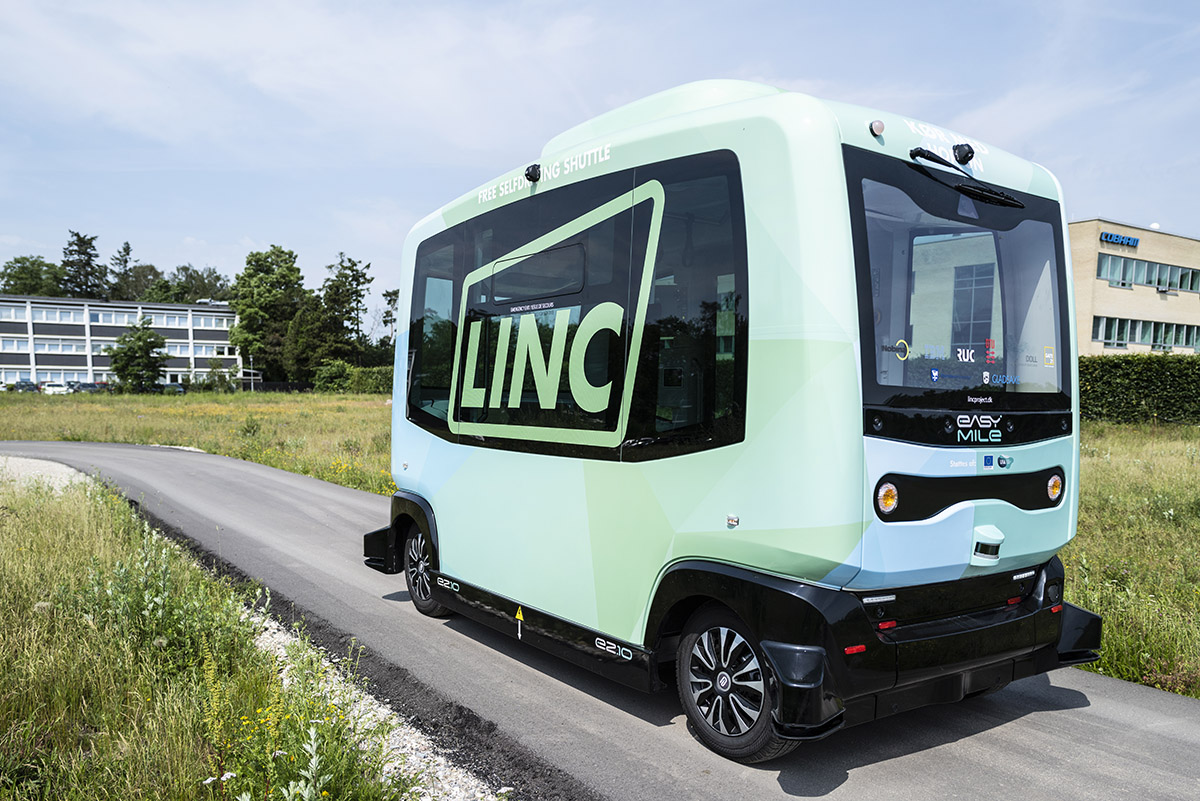Greater Copenhagen is on its way to testing driverless electric shuttles which, if successful, could form part of a future light rail link connecting Denmark’s capital to Albertslund, Gladsaxe and other outlying municipalities. The LINC project is part of efforts to ensure easier connection to mass transit, such as the Greater Copenhagen Light Rail, by combining intelligent autonomous technology and sustainable urban planning.
- 16 December 2020
The light rail and the driverless buses will help ensure that we also have smart, green and flexible ways to transport us collectively. The upcoming light rail is a decisive step, but the driverless buses can ensure that even more people will choose green and collective transport.
Autonomous shuttle buses, each carrying up to 15 passengers and legally driving at up to 20km/h on public roads in traffic, will be tested over six months at the Danish Technical University (DTU) campus (12km north of central Copenhagen) with more than 500 dedicated users. Several smaller demonstrations and tests will be done on closed roads at the Hersted Business Park in Albertslund (14km west of Copenhagen).
The tests are designed to collect information about the shuttles’ performance and commuters’ experience. DTU is developing an app, in collaboration with IBM and Roskilde University, for test users. With the help of nearly 300 Bluetooth beacons on the campus, the app will enable users to see the shuttles’ locations and allow researchers to collect data on how people use them.
Bridging the gap
LINC is an attempt to bridge the ‘first and last mile gap’ – where public transport is often not close enough to people’s homes or workplaces – and attract people to mass public transport. Here, the solution is the light rail system scheduled for completion in 2025.
The Greater Copenhagen light rail will have 29 stations and connect Copenhagen with 10 municipalities on its outskirts. This is all part of the LOOP City plan to develop Copenhagen around easily accessible public transport.
It is expected that the autonomous shuttles will increase the attractiveness and efficiency of public transport by reducing waiting times and providing schedules that respond to public demand. Since they are electric, the busses will also reduce pollution, resulting in a cleaner urban environment.
Furthermore, the project will give urban planners a better idea of the physical and digital infrastructure needed to integrate autonomous public transport into sustainable urban planning.
Clearing regulatory hurdles
Early in 2020, the Danish Road Traffic Authority approved three autonomous Easymile shuttles made in France for use in the project. They had to meet Danish safety requirements for traditional vehicles. One aspect of this year-and-a-half-long process was obtaining the correct documentation for electromagnetic radiation which is emitted by the electric shuttles.
Several hurdles remain before the first passenger can set foot on a shuttle. The entire application – a project and route description, a risk assessment and assessor's safety report – has been submitted to the Danish Road Directorate for processing.
This must then be approved by the Minister of Transport and the Danish Parliament’s transport committee. The legislation allowing the system to be put in place will need to strike a balance between innovation and safety.
According to project coordinators, testing the shuttles could start on the DTU campus late in autumn 2020. COVID-19 and ongoing restrictions on public transport have delayed the smaller demonstrations and tests planned in Albertslund.
LINC was formerly named TUPPAC: Transforming Urban Planning Providing Autonomous Collective Mobility.
The project is backed by the ERDF and Urban Innovative Actions, an EU initiative that gives cities funding to implement bold and creative projects.
Seven partners are working on the project: the municipalities of Albertslund and Gladsaxe, private companies Nobina Denmark and IBM Danmark ApS, the Technical University of Denmark and Roskilde University, and non-profit partnership organisation for a green transition Gate 21.
Total investment and EU funding
Total investment for the project “LINC – Transforming Urban Planning and Providing Autonomous Collective Mobility” is EUR 4 214 120, with the EU’s European Regional Development Fund contributing EUR 3 371 296 through the “Regional Research and Innovation” Operational Programme for the 2014-2020 programming period. The investment falls under the priority “Development of TEN-T and multimodal transport”.

